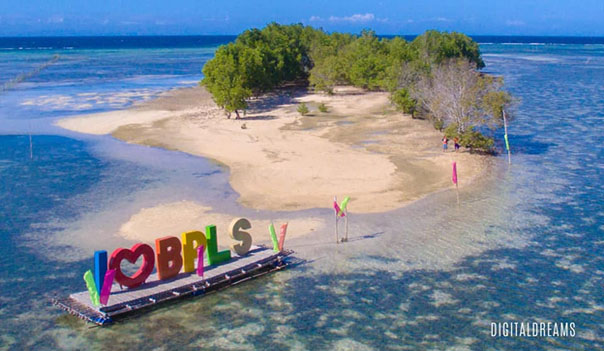
Collaboration forged between Department of Environment and Natural Resources and Misamis University for Marine Ecosystem and Coastal Biodiversity Protection: Updating of Baliangao Protected Landscape and Seascape Protected Area Management Plan 2023 to 2032
The Baliangao Protected Landscape and Seascape (BPLS) is a 315.50 hectare protected area that lies in Danao Bay, located in the Municipality of Baliangao, Misamis Occidental which is currently managed by BPLS Protected Area Management Board (PAMB) organized in October 4, 2001. It is an integrated ecosystem of mangroves, seagrass, riverine and coral reef which was declared as protected area under the Expanded National Integrated Protected Areas Act (ENIPAS) of 2018 Act or the Republic Act 11038 in July 24, 2017 pursuant to Proclamation No. 418. Its establishment as a protected area began when Danao Bay was chosen as the site for marine protection program by PIPULI Foundation in 1991. It started as a 74- hectare sanctuary that greatly contributed to the improvement of fisheries in Danao Bay as a result to the collective efforts of the foundation, some local fishers, the church and the local government. Even though initially, the marine sanctuary did not gain much support from the community, but the PIPULI Foundation persevered together with the strong support of Mayor Agne V. Yap, and continued its implementation and eventually received support from the community during the process. It later led to a municipal resolution declaring a 150-hectare sanctuary in Barangay Misom called the Misom Sea Sanctuary project which later became the BPLS. The Protected Area is about 5 kilometers from the town proper and is accessible by land and water transportation. Networks of barangay roads and trails or a ride on a motorized boat from the four (4) component barangays can lead you to the interiors of the PA. The BPLS component barangays are Misom, Sinan, Tugas and Landing.
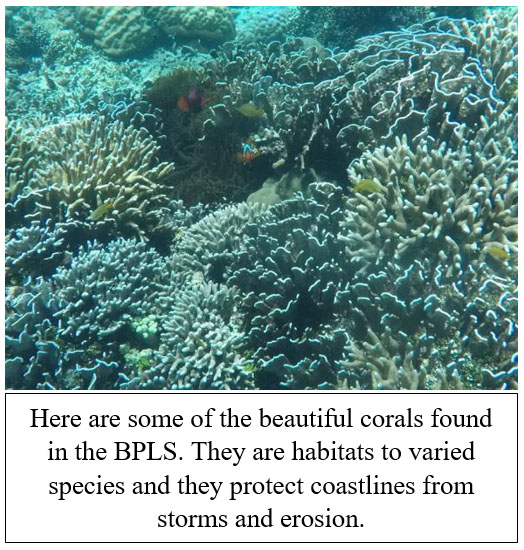
Establishment and effective management of marine protected areas is one way to preserve and promote marine and coastal biodiversity. Marine Protected Areas (MPAs) with its variety of ecosystems have many purposes and benefits. The mangroves and coral reefs serve as barrier ecosystems that protect us from the effects of natural disasters, MPAs are also safe breeding grounds for varied species most especially for key threatened species. MPAs also contribute greatly to renewing biodiversity and sustenance of growing human population. Locally, the Municipality of Baliangao is known by its beautiful white sand beaches, islets, and bountiful seafoods, including all tourism services the BPLS provides, attracting tourists from all over the province and even from the neighboring provinces, thus providing opportunities, jobs and income for locals
Although oceans cover 70% of our planet, it is faced with threats mostly caused by human activities, including effects of climate change. In the Philippines, coastlines are inhabited by more than 60% of the total population (DENR et al. 1997) and coastal areas are the prime tourism destination that comprised to 80% of tourism activities, (tourism.gov.ph, retrieved last February 8, 2022). Some intrusive human activities are overfishing, destructive fishing, illegal, unreported and unregulated fishing, and land-based pollution, among others. Although the restrictions of COVID-19 are giving a halt to tourism activities in BPLS and surrounding areas, preparation and effective management to address the persistent, present and incoming issues are essential in the management of protected and ecotourism areas.
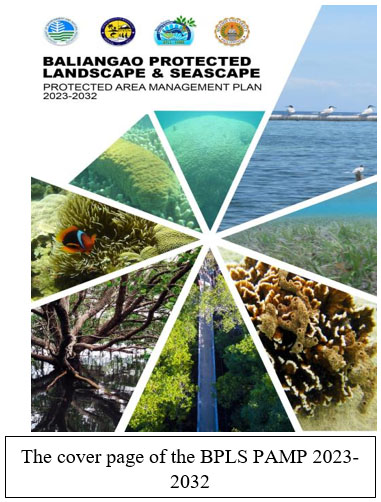
With this, Misamis University, through Misamis University Community Extension Program (MUCEP) undertook a Contract of Undertakings with the Department of Environment and Natural Resources (DENR) through the Protected Area Management Office (PAMO) of BPLS represented by DENR PENRO Rey S. Fernandez, and BPLS PAMO PASU For. Alson D. Potutan last June 7, 2021 for the updating of BPLS Protected Area Management Plan (PAMP). The signing transpired in the respective offices of the signatories in compliance with the COVID-19 IATF protocols. The updating of the BPLS PAMP were based on the issued Technical Bulletin 2018-06 “Clarifying the Protected Area Management Planning Process and Providing the Annotated Outline for Protected Area Management Plans”. The BPLS PAMP were prepared for the effective protected area management and address the present and future issues and management problems of the PA. The BPLS PAMP contains the Description of the BPLS, Current and Proposed Program, BPLS Threats, Issues and Concerns, Situational Analysis, Baliangao Protected Landscape and Seascape Protected Area Management Plan and the Monitoring and Evaluation Plan
To achieve a participatory approach in the preparation and revisions of these plans, the MUCEP Office, led by EnP. Grace. V. Villanueva, along with her staff, For. Jersam C. Calago, For. Bobby B. Alaman, Goldah Grace D. Sultan and Hanzen D. Tomatao, with BPLS PAMO staff led by PASU Alson D. Potutan, Phoebe Jane R. Aque, Jane Medija, Ranger Domingo M. . Donggon, facilitated series of consultation meetings, planning and workshop with the BPLS Protected Area Management Board (PAMB) who were at the forefront of planning the activities, and in the over-all design of BPLS PAMP & ETMP proposed strategies, programs, and projects.
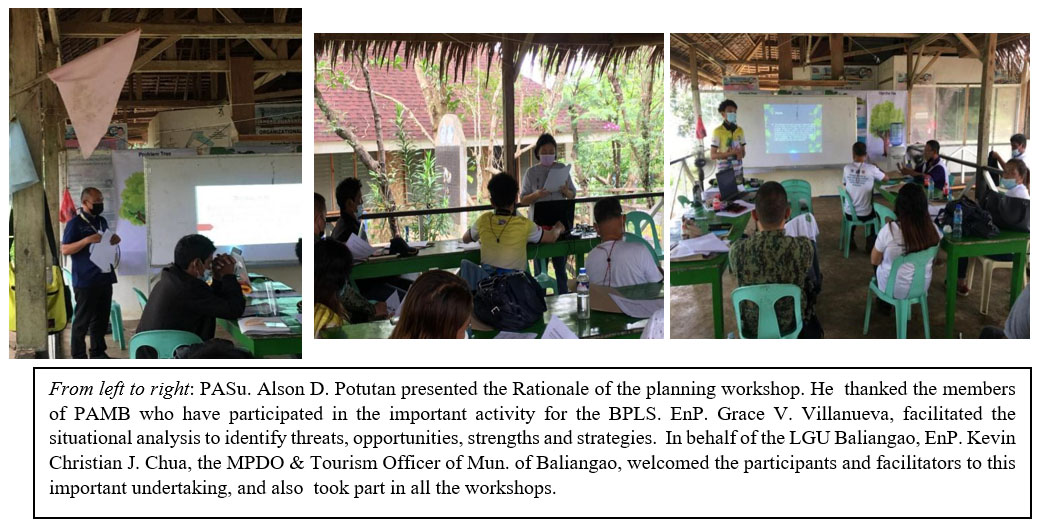
The planning workshops and situational analysis participated by the BPLS PAMB disclosed the pressing problems on natural ecosystem, human system, and management system of BPLS and likewise generated the mitigating measures through identified objectives, strategies and opportunities. With this, the BPLS PAMP would like to achieve these:
Vision: |
"The Baliangao Protected Landscape and Seascape (BPLS) aims to uphold the biodiversity conservation and protection, fosters education and research for sustainable ecosystem to become a top ecotourism destination providing recreational activities that support community livelihood for present and future generations through the strengthened effective and efficient management of PAMB, in collaboration with the local government units and the local communities." |
Mission: |
"To effectively and efficiently manage the natural resources of BPLS through collaboration with all stakeholders in the context of biodiversity conservation, ecotourism and sustainable development ." |
Goals:
1. To protect, conserve and preserve coastal and marine resources species biodiversity of BPLS for sustainable
utilization;
2. To strengthen collaboration and partnership among key players and stakeholders of BPLS;
3. To maximize the benefits of responsible ecotourism activities for sustainable development of
BPLS; and
4. Integration of Plaridel Bato Bird and Fish Sanctuary to BPLS.

Primary and secondary data were also utilized in the revision of the plans such as the BPLS Ecotourism Management Plan 1st Edition, BPLS General Management Plan 3rd Edition, Profile of BPLS, results of BPLS Management Effectiveness Assessment (MEA), Socio- Economic Assessment and Monitoring System (SEAMS), BPLS Biodiversity Assessment & Monitoring System (BAMS), maps shape files, CLUP, LCCAP and DRRMP, MEMP of the Municipality of Baliangao and BDP of 4 BLGUs adjacent to BPLS. To supplement the data of BPLS BAMS, Misamis University College of Arts & Sciences- Natural Science Department faculty, namely, Ms. Charity D. Alvarez, Ms. Emmarie F. Mapi-ot and Mr. Mark Anthony M. Manapsal, conducted a Rapid Assessment on water quality, phytoplankton and validation on seagrasses and corals in the park. The assessment was also supported by the Bureau of Fisheries and Aquatic Resources (BFAR) by lending the zooplankton net. The results of the analysis provided additional inputs that are pertinent to the profile of the park including the identified threats & recommendations endorsed to the PAMB which were then incorporated in the plans.
These joint endeavours were successfully undertaken due to the support and funding of the Department of Environment and Natural Resources - Protected Area Management Office (DENR-PAMO) BPLS led by PENRO Rey S. Fernandez. Heartfelt acknowledgement to the BPLS PAMB for their invaluable support and efforts in crafting these plans. Also, to ENP. Kevin Christian Chua, and PASu Alson D. Potutan for the assistance in acquiring pertinent information valuable to the updating of the plans. Nevertheless, earnest acknowledgement is due to the Misamis University President, Dr. Karen Belina F. De Leon for the permission and support to the MUCEP staff to facilitate these activities.

Announcement

|
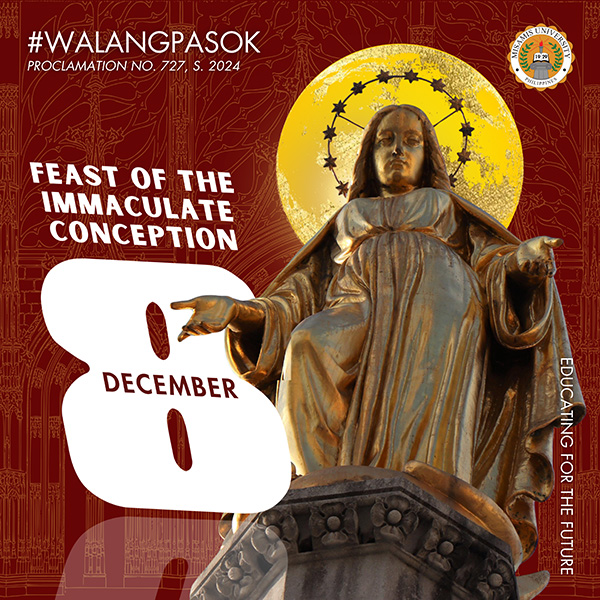
|
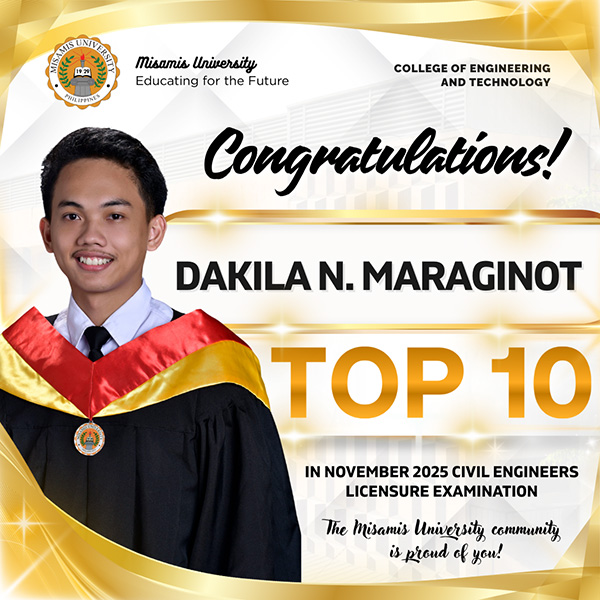
|
Photo Gallery
 2025 Cheerdance Competition
2025 Cheerdance Competition
|
 96th Foundation Anniversary Parade 2025
96th Foundation Anniversary Parade 2025
|
 International Conference on Biodiversity and Climate Change 2025
International Conference on Biodiversity and Climate Change 2025
|
Videos

|

|

|















